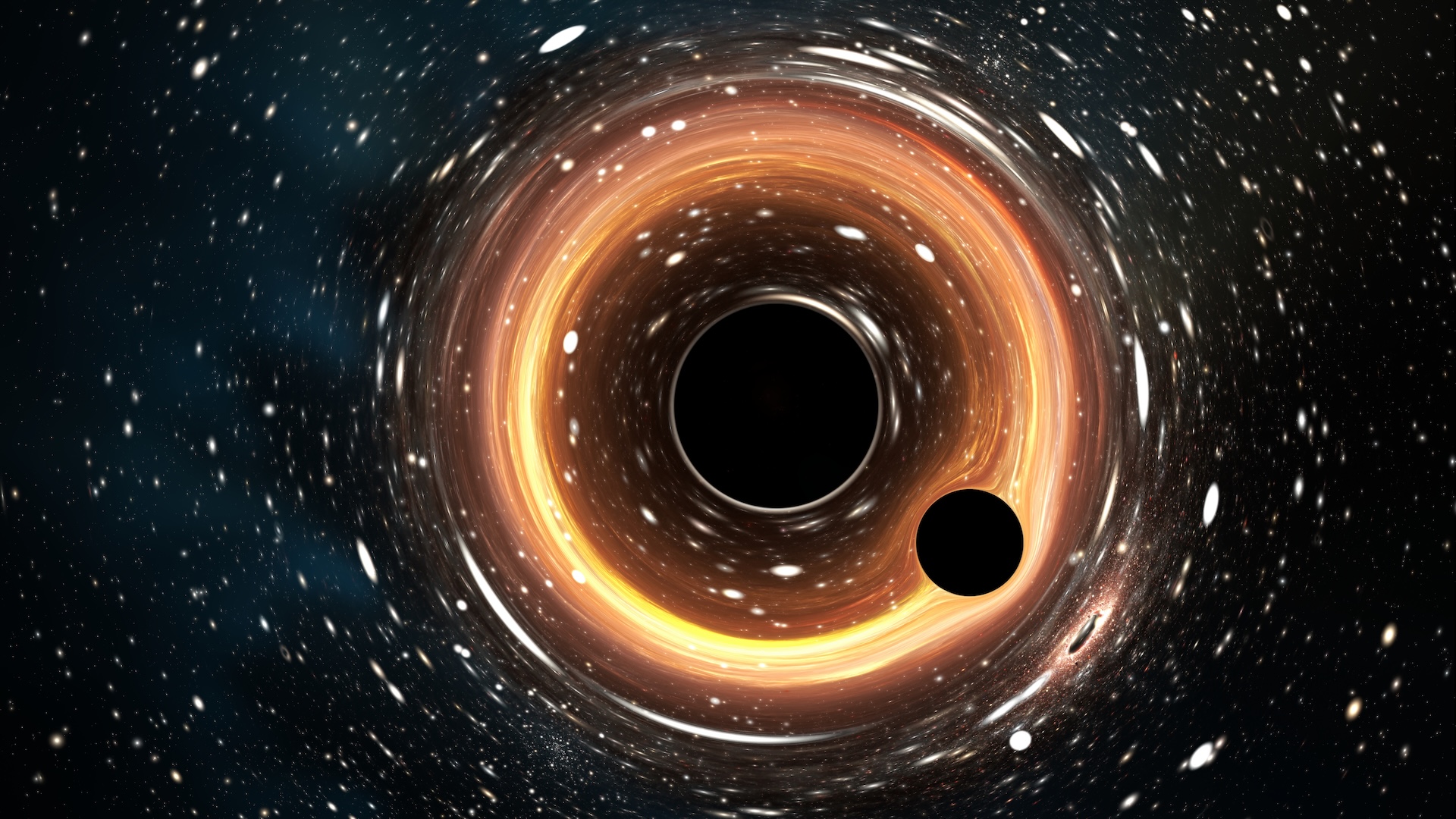Scientists use Stephen Hawking theory to propose 'black hole morsels' — strange, compact objects that could reveal new physics
Violent black hole collisions may create black hole 'morsels' no larger than an asteroid — and these bizarre objects could pave the way to unlocking new physics, a study claims.

Tiny black holes created in the aftermath of violent cosmic collisions could offer unprecedented insight into the quantum structure of space and time, a new theoretical study proposes.
What's more, signals from these "black hole morsels" could potentially be detected by current instruments, scientists reported in the study, which was published in the journal Nuclear Physics B.
"Our work shows that if these objects are formed, their radiation might already be detectable using existing gamma-ray observatories," Francesco Sannino, a theoretical physicist at the University of Southern Denmark and co-author of the study, told Live Science via email.
Hawking radiation and the smallest black holes
One of the deepest mysteries in modern physics is how gravity behaves at the quantum level. The new study offers a bold proposal to explore this regime by looking for the glow produced by tiny black holes created in the aftermath of giant black hole collisions.
The idea that black holes are not entirely black, and therefore could emit faint radiation, was first proposed by Stephen Hawking in the 1970s. His calculations revealed that quantum effects near a black hole's event horizon would cause it to emit radiation and lose mass — a process now known as Hawking radiation. The black hole temperature is predicted to be inversely proportional to its mass. So for massive astrophysical black holes, the effect is minuscule, with temperatures so low that the radiation is effectively undetectable. But for very small black holes, the situation is different.
"Black hole morsels are hypothetical micro-black holes that could be formed during the violent merger of two astrophysical black holes," Giacomo Cacciapaglia, a senior researcher at the French National Centre for Scientific Research (CNRS) and co-author of the study, said in an email. "Unlike the larger parent black hole, these morsels are much smaller — comparable in mass to asteroids — and thus much hotter due to the inverse relationship between black hole mass and Hawking temperature."
Get the world’s most fascinating discoveries delivered straight to your inbox.
Because of this elevated temperature, these morsels would evaporate relatively quickly, releasing bursts of high-energy particles such as gamma-rays and neutrinos. The team's analysis suggests that this radiation could form a distinct signal that may already be within reach of present-day detectors.
A new handle on quantum gravity
Although no such morsels have been observed yet, the researchers argue that the formation of these tiny black holes is theoretically plausible. "The idea is inspired by analogous processes in neutron star mergers," Stefan Hohenegger, senior researcher at the Institut de Physique des Deux Infinis de Lyon and co-author of the study, explained in an email. "It's supported by estimates from beyond-General Relativity frameworks, including string theory and extra-dimensional models."
In such extreme environments, small-scale instabilities might pinch off tiny black holes during the merger process. These objects, in turn, could evaporate through Hawking radiation over timescales ranging from milliseconds to years, depending on their mass.
Crucially, if such radiation is detected, it could open a window into new physics. "Hawking radiation encodes information about the underlying quantum structure of spacetime," Sannino said. "Its spectral properties could reveal deviations from the Standard Model at extreme energy scale, potentially leading to discoveries of unknown particles or such phenomena as extra dimensions predicted by various theories."
Such energy scales lie far beyond the reach of even the most powerful particle colliders, like the Large Hadron Collider at CERN. The possibility that black hole morsels might provide a natural "accelerator" for probing these physics is what makes them so compelling.
According to the team, the signature of a black hole morsel would be a delayed burst of high-energy gamma-rays radiating in all directions — unlike typical gamma-ray bursts, which are usually beamed.
Instruments capable of detecting such high-energy signals include atmospheric Cherenkov telescopes, like the High Energy Stereoscopic System (HESS), in Namibia; the High-Altitude Water Cherenkov Observatory (HAWC), in Mexico; and the Large High Altitude Air Shower Observatory (LHAASO) in China, as well as satellite-based detectors, like the Fermi Gamma-ray Space Telescope. "Some of these instruments already have the sensitivity required," Hohenegger noted.
The researchers didn't stop at theorizing. They used existing data from HESS and HAWC to place upper bounds on how much mass could be emitted in the form of morsels during known black hole mergers. These limits represent the first observational constraints on such phenomena.
"We showed that if black hole morsels form during mergers, they would produce a burst of high-energy gamma rays, with the timing of the burst linked to their masses," Cacciapaglia said. "Our analysis demonstrates that this novel multimessenger signature can offer experimental access to quantum gravitational phenomena.”
What comes next
While the study provides a compelling case for morsels, many uncertainties remain. The exact conditions for their formation are still poorly understood, and no full simulations have been performed at the scales necessary to model them. But the researchers are optimistic.
"Future work will involve refining the theoretical models for morsel formation and extending the analysis to include more realistic mass and spin distributions," Sannino said. The team also hopes to collaborate with observational astronomers to perform dedicated searches in both archived and upcoming datasets.
"We hope this line of research will open a new window into understanding the quantum nature of gravity and the structure of spacetime," Hohenegger said.
If black hole morsels exist, they may not only illuminate the sky with exotic radiation but could also shed light on some of the deepest unsolved questions in physics.

Andrey got his B.Sc. and M.Sc. degrees in elementary particle physics from Novosibirsk State University in Russia, and a Ph.D. in string theory from the Weizmann Institute of Science in Israel. He works as a science writer, specializing in physics, space, and technology. His articles have been published in AdvancedScienceNews, PhysicsWorld, Science, and other outlets.
You must confirm your public display name before commenting
Please logout and then login again, you will then be prompted to enter your display name.


